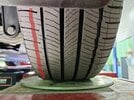A while back I noticed my Model 3 producing a rumbling noise on smoother roads, especially newly paved ones. Here’s a video I took on a newly paved road:
The wheels are well balanced and an alignment check showed no issues. The suspension on the wheels looks okay according to the mechanic I took the car to.
One thing I did find was more wear on the innermost side of all 4 tires. I’ve attached photos of each tire. There isn’t a huge difference in wear between the inner and outer sides, but been told by Tesla and other people that this is normal for Teslas given the weight of the battery.
My car is an AWD and current mileage is around 26k Miles. Did start noticing the issue close to 20k.
My question is, could higher wear on the inner tires be causing this noise? Should I be concerned about something else? Tesla service and a couple other shops I went to weren’t helpful apart from testing alignment and balancing tires.




The wheels are well balanced and an alignment check showed no issues. The suspension on the wheels looks okay according to the mechanic I took the car to.
One thing I did find was more wear on the innermost side of all 4 tires. I’ve attached photos of each tire. There isn’t a huge difference in wear between the inner and outer sides, but been told by Tesla and other people that this is normal for Teslas given the weight of the battery.
My car is an AWD and current mileage is around 26k Miles. Did start noticing the issue close to 20k.
My question is, could higher wear on the inner tires be causing this noise? Should I be concerned about something else? Tesla service and a couple other shops I went to weren’t helpful apart from testing alignment and balancing tires.



